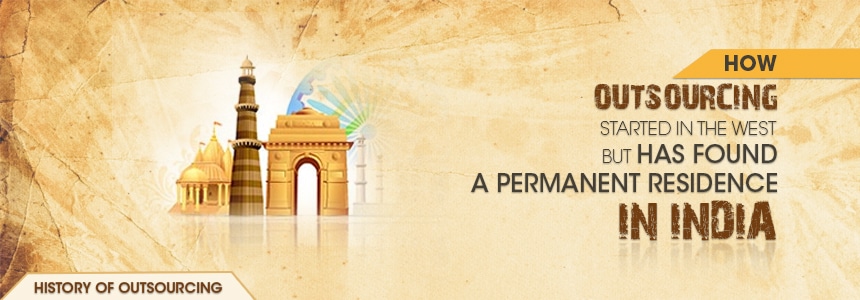How outsourcing started in the West but has found a permanent residence in India
In the present times, the outsourcing buck mostly stops in India. Hundreds of outsourcing choose to outsource to India – more than any other nation on the face of the earth. Reaching this pre-eminence has been a long journey for the Indian outsourcing industry – and one that, ironically, started in the West.
It’s a journey that received a fillip by the Industrial Revolution, globalization, freeing up of the Indian economy, and the explosion in information technology and telecommunication. The history of Indian and global outsourcing is also very much about the coming-of-age of the English-speaking educated Indian who no longer thinks twice before taking on the world.
The central character in the evolution of outsourcing is not India, the US, or even the Internet – it’s outsourcing itself – and its irreversibility. To put it bluntly, today, the US and Europe can’t afford not to outsource – not just because it makes perfect business sense but also because, without it, everyday life will turn upside down.
Outsourcing is so critical that if modern outsourcing ceases to exist for a single hour, some would say even for a minute – the world as we know it will come to a grinding halt. The cost of blackouts in communication, banking transactions, and transportation for one day will run into hundreds of billions of dollars – wiping out revenues that some countries earn in a year.
To understand outsourcing’s pervasive influence, it’s essential to extrapolate outsourcing’s origins with current trends in order to define outsourcing’s future contours – in India and globally.
In contemporary times, as many observe that outsourcing has been around ever since man developed ‘Silk Roads’ and shipping routes, to outsource is not just about earning money.
Outsourcing is about trying to outsource oneself to a location in the hope to continue to earn money. As a result, Western economies, which still form the largest trading bloc, involve multiple countries in the manufacture and delivery of their products and services, and heavily depend on outsourcing for profitability.
But outsourcing did not begin in a vacuum and it will not be re-shaped in a vacuum. The idea of outsourcing has its roots in the ‘competitive advantage’ theory suggested by Adam Smith in his book ‘The Wealth of Nations’, which was published in the year 1776. This theory gained acceptance during the Industrial Revolution as companies mechanized and kept labor costs low to have an advantage over competition.
As land, shipping, and air routes developed between the 15th and 21st centuries more nations looked to outsource trade to more nations. In pre-telecommunication decades, companies would mostly outsource manufacturing of textiles, leather goods etc. In the years after advances in telecommunication and foreign travel, companies started to outsource heavy machinery and auto parts to geographically near countries.
With the development of fiber optics and satellite communication, Internet enabled immediate communication and transfer of data. And as soon as Internet penetration increased globally, the potential to outsource communication-dependent services became possible. The build-up of technological advances came to a head in mid 1990s, making it possible for companies to outsource entire global processes and services to remote locations.
So when the US and Europe faced a shortage of skilled workers due to after-effects of the dotcom bust in the mid and late 90s, US companies, increasingly concerned about profit margins, decided to outsource back office work abroad.
When clients first dipped their toes in India’s outsourcing waters, they decided to outsource basic customer care. Soon India’s IT and telecommunication infrastructure became competent enough for clients to outsource more complex projects. In due time, India became a destination for critical software applications.
Today, if companies want to overhaul their IT systems or develop engineering automation, India is the first, and most often the last stop. Clients not only want to outsource management of knowledge but also want to outsource whole technology or function-based businesses.
And if one were to look through the outsourcing looking glass, in eight to ten year’s time companies would begin to outsource ‘core’ business functions like corporate planning and product development.
By that time India would have reversed brain drain, massively uplifted its infrastructure, and mastered the art and science of getting under the skin of any MNC in any business anywhere in the world.
The least the history of outsourcing requires is a tome. But the following sections encapsulate the turning points in the fascinating story of outsourcing.
Time line of evolution of outsourcing from the West to the East:
1776: Scottish political economist Adam Smith in his book Wealth of Nations ideates concept of ‘competitive advantage’, a precursor to outsourcing – through division of labor, which the West would later outsource.
18th and 19th centuries: The idea of ‘offshore manufacturing’ becomes operational with huge whaling fleets and massive floating factory ships – in which many people live and work for months and years – and often change locations depending on where they sight opportunity.
Early 20th century: Competitive advantage and cost-effective use of resources is seen in Ford Motors, which owns everything it needs to produces its products – even forests to make rubber for car tires.
1940s: American company Automatic Data Processing (ADP) begins operations to handle payroll. Today the $9 billion ADP has 570,000 clients, handles payrolls for one in six US workers, and recently decided to outsource to India.
1960s: Hundreds of call centers spring up in the US and UK. Companies from oil majors, telecom operators, pharma firms to FMCG firms, outsource customer care, telemarketing, payroll etc.
1983: Infosys wins first client – Data Basics Corporation of the US, which chooses Infosys to outsource software development.
Mid 80s: Global Airlines outsource back office, open offices in New Delhi. They were quickly joined by firms like American Express to outsource region based data management.
1985: American company Texas Instruments decides to outsource to India for the first time. Opens office in Bangalore.
1989: Jack Welch visits India and kicks-off GE off shoring initiative. Welch’s visit triggers rapid growth of captive services for non-Indian operations, and the start of the first large offshore operation in India.
1980-1990: Companies from the US and Europe start sending work to countries like Canada, Israel and Ireland. Endowed with a multi language culture and lower labor cost, Ireland makes the most of this opportunity. At the peak of this practice Ireland had over 100 call centers that employed more than 30,000 people.
1990-1999:A professor of Indian origin, C.K. Prahalad explains the theory of core competencies in a Harward Business School paper. The crux of the theory was that one should identify their core competencies and should get rid of everything else. The western business community was intrigued by this and companies like British Airways, American Express and General Electric took the initiative to start their captive offices in India.
1997-2001: Internet and telecommunication boom makes waves in India and across the world. Indian government, US companies invest heavily in laying countrywide fiber optic network for Internet penetration.
1996-2000: Globally, companies outsource Y2K related outsourcing projects to India.
1999: India initiates New Telecom Policy 1999; it ends state monopoly on international calling facilities; heralds growth of inbound/outbound call centers and data processing centers. Medical Transcription becomes one of the first outsourced services to third party players.
2000-2005: Indian mobile and broadband market explodes into action, and records phenomenal growth over the next nine years. India’s English-educated technical and non-technical graduates start paying rich dividends. Third party outsourcing players spring up in India; by 2005 end, over 300 open shop in India and beyond; about 45 global destinations compete to get a slice of the annual $300 billion outsourcing pie; MNCs establish wholly owned subsidiaries to cater to off shoring requirements of their parent companies.
2009: Bucking worldwide recessionary trends, India, the most favored outsourcing destination since 2004, records 12 per cent growth in IT-BPO in 2008-09 to reach $71.7 billion in aggregate revenue.
How America let the outsourcing Genie out of the bottle:
In the mid 1980s, American automaker General Motors took what was then a very unusual step and shut down 10 factories in America and moved them to Mexico. US companies looked at outsourcing and saw a return to profitability. Soon US automakers began to outsource to Canada due to its lower labor wages, and an English-speaking population.
Following GM’s trend-setting move, American and Japanese electronics firms such as Toshiba, Motorola, and Texas Instruments began to outsource production to low cost outsourcing locations such as Taiwan and Singapore.
The trend began to accelerate during the 1990s with the signing of North America Free Trade Agreement – after which American firms began looking at Mexico as both a market for export and a potential center of production.
Growing software capabilities prompted companies to outsource to India:
The US and other countries first looked to outsource to India after Indian outsourcing companies developed competence in IT-enabled services. Indian competency in complex inter-functional software was an important reason why these nations choose to outsource to India.
After going through four stages of development, Indian software programming brain power now attracts clients across the world to outsource applicative software projects.
1970s to early 1990s: Shortage of skills; though ‘outsource to India to lower costs’ starts to become reality.
1994-1998: Post-liberalization reforms help already existing IT companies speed up expansion; government provides incentives for companies to outsource; clients outsource medium and large application projects on legacy migration and enterprise wide IT and problems related to Y2K syndrome; Indian outsourcing companies acquire diverse skills and execution capabilities.
1999-2001: IT and outsourcing companies acquire competence in enterprise resource planning and customer relationship management; make investments in R&D; gain world-class project management capabilities; clients outsource IT consulting.
2001 to present: Clients outsource large application development and maintenance; large corporations outsource chalking out and executing IT strategies; Indian outsourcing companies are now in the process of aggressively gaining expertise for carrying out high-end work such as R&D, architecture and business integration.
How Indian outsourcing grew due to Internet and telecommunication boom:
For western economies to outsource services to save costs it was essential that the location for outsourcing had adequate telecommunication and Internet infrastructure. India did not have this till the late 90s.
Introduction of the National Telecom Policy (NTP) in 1999 and deregulation of the telecommunication industry opened up national, long distance, and international connectivity to competition. The cost of managing work in a distant location fell dramatically, and a core requirement to outsource became a reality.
Soon, the Indian government identified ITES (Information Technology Enabled Services) as a key contributor to economic growth, and for companies to outsource to India. The thrust towards ITES enabled the establishment of Software Technology Parks and Export Enterprise Zones.
India’s National Association of Software and Service Companies (NASSCOM) too played a critical role in outsourcing as an ‘advisor, consultant and coordinating body’ for the outsourcing industry. It created a platform for the dissemination of knowledge and research in the outsourcing industry through its surveys and conferences.
Companies now outsource to gain from strategic partnerships:
According to American professor Rob Handfield, who wrote ‘A Brief History of Outsourcing’, outsourcing was not formally identified as a business strategy until 1989. In the 1990s, as organizations began to focus more on cost-saving measures, they started to outsource those functions necessary to run a company but not related specifically to the core business.
Before companies took to entering into strategic partnerships, not many companies would outsource core competencies –
as they give the company a strategic advantage. This attitude changed in the 1990s when clients decided to outsource some core functions like customer service – precisely because it is so important.
Eastman Kodak’s decision to outsource its critical information technology systems was considered revolutionary in 1989. But it was actually the result of rethinking what their business was about. Dozens of major corporations followed in Kodak’s footsteps as they realized it was not necessary to own the technology to get access to information they needed.
The focus in outsourcing today is less on ownership and more on developing strategic partnerships to bring about enhanced results. Consequently, organizations are likely to outsource more on the basis of who can deliver more effective results for a specific function than on whether the function is core or commodity.








